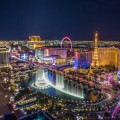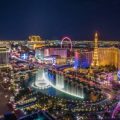
Las Vegas, a city synonymous with flashing lights, non-stop action, and world-class entertainment, boasts a past far less glamorous. Its journey from a dusty desert town to the “Entertainment Capital of the World” is a remarkable tale of reinvention, driven by ambition, shifting tides, and a relentless pursuit of spectacle. Let’s embark on a historical odyssey, decade by decade, to uncover the key moments that transformed Las Vegas from a mob-run city into the dazzling oasis it is today.
1905-1930s: From Humble Beginnings to Gambling Oasis
Las Vegas started as a quiet railroad town, its fortunes hinging on the construction of the Hoover Dam in the 1930s. This massive project attracted thousands of workers, creating a demand for entertainment and leisure. Nevada, seizing the opportunity, legalized gambling in 1931, paving the way for the city’s iconic future. Enterprising individuals, including mob figures like Bugsy Siegel, saw potential in this budding oasis and began investing in casinos and hotels, laying the foundation for Las Vegas’ association with gambling.
1940s-1950s: The Rat Pack Era and Mob Dominance
The post-war boom saw Las Vegas flourish as a playground for celebrities and high rollers. The “Rat Pack,” led by Frank Sinatra and Dean Martin, became synonymous with the city, attracting tourists with their electrifying performances. Behind the glitz and glamour, however, the mob held significant control. Casinos were often owned and operated by organized crime, infusing the city with an air of danger and intrigue. While this era established Las Vegas as a gambling destination, its image remained tied to underworld influences.
1960s-1970s: Breaking Free from the Mob & Corporate Takeover
The tide began to turn in the 1960s. Howard Hughes, a powerful tycoon, started buying up casinos, displacing some mob influence. Additionally, the Corporate Gaming Act of 1967 made it easier for legitimate corporations to enter the Las Vegas market, further weakening the mob’s grip. This era also saw the rise of family-friendly attractions like Circus Circus, marking a shift towards a more diverse and accessible tourism experience.
1980s-1990s: Mega-Resorts and Diversification
The 1980s witnessed the dawn of the mega-resort era. Pioneered by Steve Wynn’s The Mirage in 1989, these sprawling complexes combined luxury accommodations, high-end gaming, and world-class entertainment under one roof. This marked a significant departure from the traditional casino-centric model, attracting a wider range of tourists and solidifying Las Vegas’ position as an entertainment destination. The 1990s saw further diversification with the introduction of themed resorts like New York-New York and Paris Las Vegas, solidifying the city’s reputation as a fantasy escape.
2000s-Present: Globalization, Innovation, and the Rise of Non-Gaming Experiences
The 21st century brought globalization and increased competition from other gambling destinations. To stay ahead, Las Vegas embraced innovation, incorporating cutting-edge technology, diverse dining experiences, and high-profile shows like Cirque du Soleil. The focus shifted from solely offering gambling to providing immersive, non-gaming experiences that appealed to a broader audience. Additionally, international partnerships and marketing efforts made Las Vegas a truly global destination.
The Future of Las Vegas: Sustainable Growth and Redefining Entertainment
Las Vegas continues to evolve, facing challenges like environmental sustainability and competition. The city is actively pursuing eco-friendly initiatives and diversifying its offerings beyond just gambling and entertainment. The focus is on creating a more sustainable and inclusive experience, attracting residents and businesses alongside tourists. As Las Vegas embarks on this new chapter, one thing remains certain: its ability to adapt, reinvent, and redefine entertainment will continue to shape its future as a global icon.
Article above assisted by Google Bard, article below assisted by ChatGPT.
Las Vegas: From Mob Rule to Entertainment Capital
Las Vegas, known today as the Entertainment Capital of the World, has a storied past marked by transformation and growth. This article will explore the city’s evolution from its early days dominated by organized crime to its current status as a global hub for entertainment, leisure, and luxury. We’ll delve into the pivotal moments and changes from each decade that have shaped Las Vegas into the dazzling destination it is today.
The Early Years: The 1900s to 1940s
Las Vegas was officially founded as a city in 1905. In its early years, it was a small railroad town, serving as a stopover for travelers. The legalization of gambling in Nevada in 1931 marked the beginning of Las Vegas’s transformation. Small casinos and gaming venues started to appear, laying the groundwork for what would become a booming entertainment industry.
The 1940s: This decade marked a significant turning point with the construction of the El Rancho Vegas, Las Vegas’s first resort on what would later become the famous Las Vegas Strip. This era also saw the arrival of Bugsy Siegel, a notorious mobster, who played a pivotal role in the development of the Flamingo, one of the Strip’s first major casinos. Despite Siegel’s violent end, the Flamingo’s success set a precedent for future development, establishing Las Vegas as a potential goldmine for gaming and entertainment.
The 1950s: The Mafia’s Heyday
The 1950s saw Las Vegas’s rapid expansion, fueled by both legitimate investments and mob money. This era was characterized by the opening of several iconic casinos, including the Sahara, the Sands, and the Tropicana, which were financed and operated by figures with strong ties to organized crime. Las Vegas during this time was a blend of glamour and underhand dealings, with the mafia playing a central role in the operations of many casinos.
The 1960s: Corporate Involvement Begins
The 1960s marked the beginning of a slow shift away from mob control. The era was heralded by the construction of the Rat Pack’s favorite haunt, the Sands Hotel and Casino, and the luxurious Caesars Palace, which opened in 1966. These developments signaled a move towards corporate ownership and management in the hotel and casino industry, though the mob still maintained a significant presence.
The 1970s: The Howard Hughes Effect
The transformation of Las Vegas gained momentum in the 1970s, largely due to billionaire Howard Hughes. Hughes began buying up casinos and hotels on the Strip, pushing out mobsters and introducing corporate structures. His influence helped start the process of legitimizing Las Vegas’s business operations, reducing organized crime’s grip on the city.
The 1980s: The Renaissance Begins
The 1980s were a decade of rejuvenation and expansion for Las Vegas. The city began to diversify its offerings, with the construction of mega-resorts that emphasized entertainment and family-friendly attractions alongside gaming. This period saw the opening of the Mirage in 1989, the first new resort on the Strip in 16 years, which sparked a building boom that transformed Las Vegas into a destination for more than just gamblers.
The 1990s: The Boom Continues
Las Vegas’s transformation continued through the 1990s with the opening of several landmark properties, including the MGM Grand, the Bellagio, and the Venetian. These resorts were lavish and offered a wide range of entertainment options, from high-end shopping and dining to spectacular live shows, setting new standards for what visitors could expect.
The 2000s: The Age of Luxury and Expansion
Entering the new millennium, Las Vegas solidified its reputation as a luxury destination. The 2000s saw the rise of opulent hotels, high-end restaurants helmed by celebrity chefs, and the introduction of extravagant nightclubs. The city also began to attract significant international investment, further diversifying its economic base and entertainment offerings.
The 2010s and Beyond: Diversification and Innovation
The most recent decade has seen Las Vegas continue to evolve, with a focus on diversifying its appeal beyond gaming. The city has embraced sports, hosting NFL and NHL teams, and has become a major hub for conventions and music festivals. Furthermore, Las Vegas continues to innovate in entertainment, with residencies by world-renowned artists and immersive entertainment experiences becoming increasingly popular.
Conclusion
Las Vegas’s journey from a mob-run city to the Entertainment Capital of the World is a testament to the city’s ability to reinvent itself. Each decade brought new changes and challenges, but through innovation, investment, and a move towards corporate governance, Las Vegas has managed to emerge as a glittering jewel in the desert. Today, it stands as a global symbol of entertainment, luxury, and endless possibilities, attracting millions of visitors from around the world each year.







